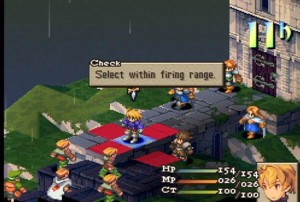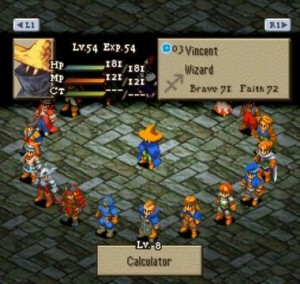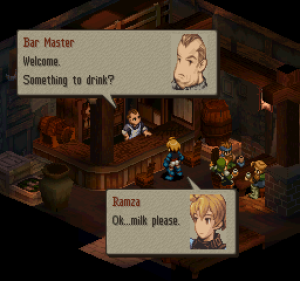RPG meets Chess
Final Fantasy Tactics
Squaresoft | Playstation | January 1998
Nostalgia Reviews look back and highlight the greatest games of previous generations. The review is rooted in fond memories and appreciation of the game during that era. There are times when memories differ from reality or modern techniques are superior to earlier design.
Final Fantasy is a cash cow for Squaresoft. They can (and have) slap FF on a game that is decidingly not in line with the JRPG franchise and receive increased media coverage, fan reception and sales. Final Fantasy Tactics benefited from being attached to the franchise but is an excellent game that stands on its own merit.
The story is set in Ivalice, a medieval-era society that is entrenched in war. Players control Ramza a noble-born son (kind of looks  like a girl during the first chapter) and his team of knights/mercenaries. After the death of the King, a power vacuum occurs and warring factions jostle to put their chosen heir on the throne. Ramza’s party is caught in the intrigue, fights both factions and uncovers a greater threat to the realm.
like a girl during the first chapter) and his team of knights/mercenaries. After the death of the King, a power vacuum occurs and warring factions jostle to put their chosen heir on the throne. Ramza’s party is caught in the intrigue, fights both factions and uncovers a greater threat to the realm.
Battles take place on a battlefield dissected into a grid where characters take turn to move and attack. Each combatant has a movement and speed stat which determines when they can change positions and how far they can progress. Once Ramza’s team completes the objective for the mission, the battle concludes. The player controlled party starts as entry-level squires and chemists (the only job capable of using items) and progress to become powerful ninjas or summoners. Effective team management outside of conflict is as necessary as during battles in order to win.
What is a Critical Hit!
The class system within FFT is one of the most robust RPG mechanics. Each character is able to select a job, which for generic soldiers also alters their appearance, as well as a secondary job, support skill, counter ability and movement trait. As characters level up the lower jobs, they unlock more advanced classes; for example, squire unlocks archer who unlocks thief. There are nineteen jobs in total, some of which require specific levels in multiple sub-jobs. Within each class, combatants earn specific job points for completing tasks such as healing an ally or killing a rival. Players spend job points on any of the skills within the class at their discretion. If you want to unlock Bolt for 50 jp, go for it or save up 1,000 jp and gain access to the devastating Flare. Once multiple skills and abilities are unlocked for a character unique creations become available. If you ever wanted a duel wielding, teleporting knight who casts white magic, it’s possible.
After tweaking the team to create the perfect party, players engage in random battles or story missions. The random battle win condition is always kill all enemies but missions could be reach a specific point or defeat the leader. The player is outnumbered on  almost every battle and a thought out strategy is required. Players can review the available skills and movement of the enemy before moving to determine what a safe course of action is. An all out offensive strike is not always the best or course of action. If an ally soldier falls, a counter appears over their head; once it reaches zero that character is lost forever. It might not be critical to lose a squire in the first chapter, but the permanent loss of your level 65 lancer is a hard fact to swallow.
almost every battle and a thought out strategy is required. Players can review the available skills and movement of the enemy before moving to determine what a safe course of action is. An all out offensive strike is not always the best or course of action. If an ally soldier falls, a counter appears over their head; once it reaches zero that character is lost forever. It might not be critical to lose a squire in the first chapter, but the permanent loss of your level 65 lancer is a hard fact to swallow.
The story echoes familiar sentiments as the popular Game of Thrones. Nobles are fighting over the throne, peasants are rebelling, allegiances are shifting and fans never know to trust. FFT does not hold the player’s hand throughout the story and isn’t afraid to touch on mature themes of poverty, death, incest, and revenge. The conspiracy Ramza discovers is centered on the church’s influence in the conflict. Allusions to corruption with the Crusades-era Catholic Church and the role of religion with Ivalice are present within the story. Throughout it all, there are new allies and enemies introduced and a myriad of plot twists.
The over world map is easy to navigate and determine where the next story mission takes place. Players start off with one location after completing the first battle. As the game progresses, new locations are unlocked on the map and paths are drawn from point to point. By the endgame the map will contain fifty potential locations to visit, with intertwining paths that would be overwhelming if dropped all at once.
Entire battles, playable characters and weapons are unlocked only through sidequests. Fan favorite, Cloud Strife, from FFVII, returns as a playable character, if you are able to complete a somewhat arbitrary series of events to recruit him. There is a bonus dungeon, where the most powerful swords can be discovered, but to unlock it players must ask the right barkeep the right series of
questions. It’s a great way for hardcore players to interact with the world and look over every section of the game. If you want to streamline the process, there are many guides easily available.
What is Not Very Effective…
The localization of FFT is a reference point for how not to do the job. There are fragmented sentences, misspellings and odd word choice throughout the tale. And while the story can be engaging and contain deep motivations from characters, it can be confusing.  With shifting allegiances, plots within plots and a large cast who sometimes look like someone else it is easy to get lost within the story. There are still people who debate the fate of Delta during the game’s final moments. Additionally, the story unfolds slowly in some sections with large sections of dialogue that reiterate the same point.
With shifting allegiances, plots within plots and a large cast who sometimes look like someone else it is easy to get lost within the story. There are still people who debate the fate of Delta during the game’s final moments. Additionally, the story unfolds slowly in some sections with large sections of dialogue that reiterate the same point.
There is a steep learning curve. Players control of every aspect of the party’s stats. This includes items, money, troop deployment and jobs. This opens up the possibilities for variety and players to micro-manage characters but it can be overwhelming at first. The tutorial does not do a good job explaining how the process works.
The story missions are uneven and unbalanced. If players only progress through missions, they will hit a difficulty spike that cannot be overcome. Alternatively, if players spend the first chapter unlocking top-tier jobs and abilities they will be able to steamroll through the competition. Random encounters do not have this same issue as the monster level matches the highest in the party. But this opens up the possibility for problems if one character is ten levels higher than the rest of the team. There are a story sections where multiple battles must be completed in succession without returning to the over world map. If players don’t have a backup save and hit an impossible battle in the middle of a series….they might need to start the game over.
Status Summary
Taking the best parts of the Final Fantasy franchise, enjoyable battle system, steam-punk aesthetics and an escalating story, and adding in a battlefield where terrain is as important to consider as the enemy, Tactics proves to be worthy of the namesake. Fans of the series will instantly recognize the naming conventions of classes, items and weapons and newcomers will be able to jump in without any prior knowledge.
If you prefer twitch based games, simple plots or playing games for a few minutes at a time, then this game is not a good strategy for you. If you enjoy robust systems, overcoming challenging scenarios and unraveling a multilayered plot then this game is an obvious move.
Score: 9.5 /10
+ Class System
+ Battle Strategy
+ Secrets
+ Intricate Story
– Complicated Story
– Unbalanced Battles
Level Up, Friends!
